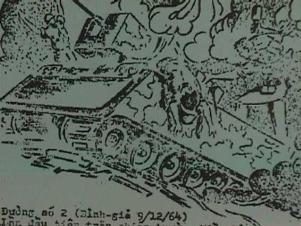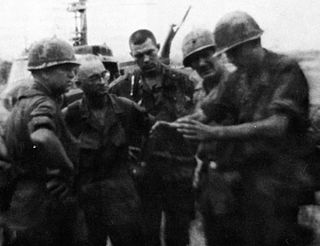
The Battle of Binh Gia was conducted by the Viet Cong (VC) and People's Army of Vietnam (PAVN) from December 28, 1964, to January 1, 1965, during the Vietnam War in Bình Giã, Phước Tuy Province, South Vietnam.

The Battle of Ong Thanh was fought at the stream of that name on the morning of 17 October 1967, in Chơn Thành District, at the time part of Bình Dương Province, South Vietnam, today in Bình Phước Province.

The Battle of Xa Cam My was fought over two days from April 11–12, 1966, 10 miles (16 km) south of the village of Cam My in Phuoc Tuy Province, during the Vietnam War. Originally planned as a U.S. search and destroy mission intended to lure out the "crack" Viet Cong (VC) D800 Battalion, Charlie Company, 2nd Battalion, 16th Infantry Regiment soon found itself fighting for survival in the rubber plantations of Cam My village, approximately 42 miles (68 km) east of Saigon. During this battle 134 men of Charlie Company, 2/16th Infantry were ambushed by the VC and 80 percent became casualties.

The First Battle of Loc Ninh was a battle during the Vietnam War that occurred between 29 October and 7 November 1967, fought by the Viet Cong, Army of the Republic of Vietnam (ARVN), Civilian Irregular Defense Group and the United States Army.

The 25th Division of the Army of the Republic of Vietnam (ARVN)—the army of the nation state of South Vietnam that existed from 1955 to 1975—was part of the III Corps that oversaw the region of the country surrounding the capital, Saigon. It was based at Củ Chi Base Camp to the northwest of the city.

Operation Toan Thang I was a U.S. Army, Army of the Republic of Vietnam (ARVN), 1st Australian Task Force and Royal Thai Volunteer Regiment operation conducted between 8 April and 31 May 1968 in the Vietnam War. The operation was part of a reaction to the Tet Offensive designed to put pressure on Vietcong (VC) and People's Army of Vietnam (PAVN) forces in III Corps.

Michelin Rubber Plantation was located near Dầu Tiếng District in Bình Dương Province, 72 km northwest of Saigon. The plantation was established by the Michelin company in 1925 and at 12,400 hectares it was the largest rubber plantation in Vietnam. The plantation was located approximately halfway between the Cambodia border and Saigon and so was an important base and staging area for the Viet Cong (VC) and later the PAVN. The plantation was an important source of revenue for the South Vietnamese Government and it was believed that the Michelin Company paid off the VC in order to keep the plantation operating during the war. US forces were obliged to compensate Michelin for damage caused to the rubber trees during operations in the plantation.
The second Battle of Bàu Bàng occurred during the night of 19–20 March 1967 during Operation Junction City, a search and destroy mission by American military forces in Tay Ninh Province of South Vietnam, to the west of the capital Saigon.
The Battle of Ap Gu occurred during 31 March and 1 April 1967 during Operation Junction City, a search and destroy mission by American military forces in Tay Ninh Province of South Vietnam, to the west of the capital Saigon. The battle near the border with Cambodia left 609 Viet Cong (VC) killed according to US sources, with 5 captured, and over 50 weapons of all types recovered, while the Americans lost 17 killed and 102 wounded.

Dầu Tiếng Base Camp is a former U.S. Army and Army of the Republic of Vietnam (ARVN) base in the Dầu Tiếng District in Bình Dương Province in southern Vietnam.

The Battle of Ap Bau Bang took place on the morning of 12 November 1965 when two regiments from the Viet Cong (VC) 9th Division attacked a night defensive position of the United States 2nd Battalion, 2nd Infantry Regiment at a small village (ấp) by the name of Bàu Bàng, 25 km north of Thủ Dầu Một.
Operation Amarillo was an operation conducted by 1st Brigade, 1st Infantry Division in Bình Dương Province, lasting from 23–31 August 1966.

Operation Yellowstone was an operation conducted by the 1st and 3rd Brigades, 25th Infantry Division in northeast Tây Ninh Province, lasting from 8 December 1967 to 24 February 1968.
Operation Hop Tac I was a road security operation conducted during the Vietnam War by the U.S. 9th Infantry Division along Route 4 in Dinh Tuong Province, South Vietnam from 10 February to 10 March 1968.

Operation Billings was a US search and destroy operation conducted by the 3rd Brigade, 1st Infantry Division north of Phước Vĩnh during the Vietnam War. The operation was conducted from 12 to 26 June 1967.
Operation Shenandoah II was a security operation conducted during the Vietnam War by the U.S. 1st Infantry Division to secure and repair Highway 13, South Vietnam from 29 September to 19 November 1967.
Phase III of the Tet offensive of 1968 was launched by the People's Army of Vietnam (PAVN) and Viet Cong (VC) from 17 August to 27 September 1968. The offensive was divided into two waves of attacks from 17 to 31 August 1968 and from 11 to 27 September of that same year.

Operation Imperial Lake was a U.S. Marine Corps, Republic of Korea Marine Corps and U.S. Army operation in the Quế Sơn District, Quảng Nam Province, South Vietnam that took place from 1 September 1970, to 7 May 1971. It was the last operation of the 1st Marine Division during the Vietnam War.

The attacks on Biên Hòa, Bien Hoa Air Base and Long Binh Post, occurred during the early hours of 31 January 1968 and continued until 2 February 1968. The attacks by Vietcong (VC) and People's Army of Vietnam (PAVN) forces were one of several major attacks around Saigon in the first days of the Tet offensive. The attacks were repulsed with the VC/PAVN suffering heavy losses, having inflicted minimal damage on the bases.
Operation Nevada Eagle was a security operation during the Vietnam War in Thừa Thiên Province, that took place from 17 May 1968 to 28 February 1969.













